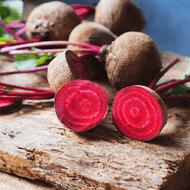Ingredient Glossary: Beetroot
Posted by Emily on 1st Dec 2019 Reading Time:
What is Beetroot?
Once a staple in 1970s British salads where it was typically cooked and pickled in vinegar, beetroot is a vibrant root vegetable with a deep purple exterior and a rich pink to purple inside. It's recently regained popularity thanks to its distinct sweet and earthy flavour, making it versatile for both sweet and savoury dishes. Closely related to spinach and chard, beetroot is nutritionally rich and is believed to have detoxifying properties. Discover more about the health benefits of beetroot in our detailed guide.
Preparing Beetroot
If you're cooking beetroot whole, wash, but avoid peeling. Trim the stalks to about 2.5cm, keeping the root intact. Over-trimming can cause the colour to bleed. For oven cooking, either wrap the beetroot in foil or place it in a lidded casserole dish with water, then bake at a low temperature for 2-3 hours. You can also simmer it for about an hour after the same initial preparation. Raw beetroot can be a delicious addition to salads when peeled and grated or finely sliced for a 'carpaccio'. Once washed and trimmed, its leaves can also be used in salads or as a garnish.
Cooking Methods for Beetroot
- Roast it, then mix with walnut oil and chives.
- Drizzle with olive oil and cumin seeds, bake, top with feta, and bake once more.
- Boil for a short period, drain, and serve with either olive oil or butter.
Storing Beetroot
Keep fresh beetroot in a cool, dark area that'll stay good for weeks. Pre-cooked and vacuum-sealed beetroot is also available – excellent for pickling, roasting, or adding to salads. This type lasts for months when refrigerated.
Grow Your Own Beetroot
When is Beetroot Available?
You can find fresh beetroot mainly from July to January, with supplies dwindling in February and March. For gardening enthusiasts, beetroot is a hassle-free vegetable to cultivate in gardens or allotments.
Selecting the Best Beetroot
When purchasing raw beetroot, look for fresh, non-droopy stalks and firm roots.

